PBS: Escaping Eritrea … [Read More...] about ካብ ውሽጢ ቤት ማእሰርታት ኤርትራ
All Is Not Forgiven: South Africa and the Scars of Apartheid
Sisonke Msimang | January/February 2018 Issue | Foreign Affairs
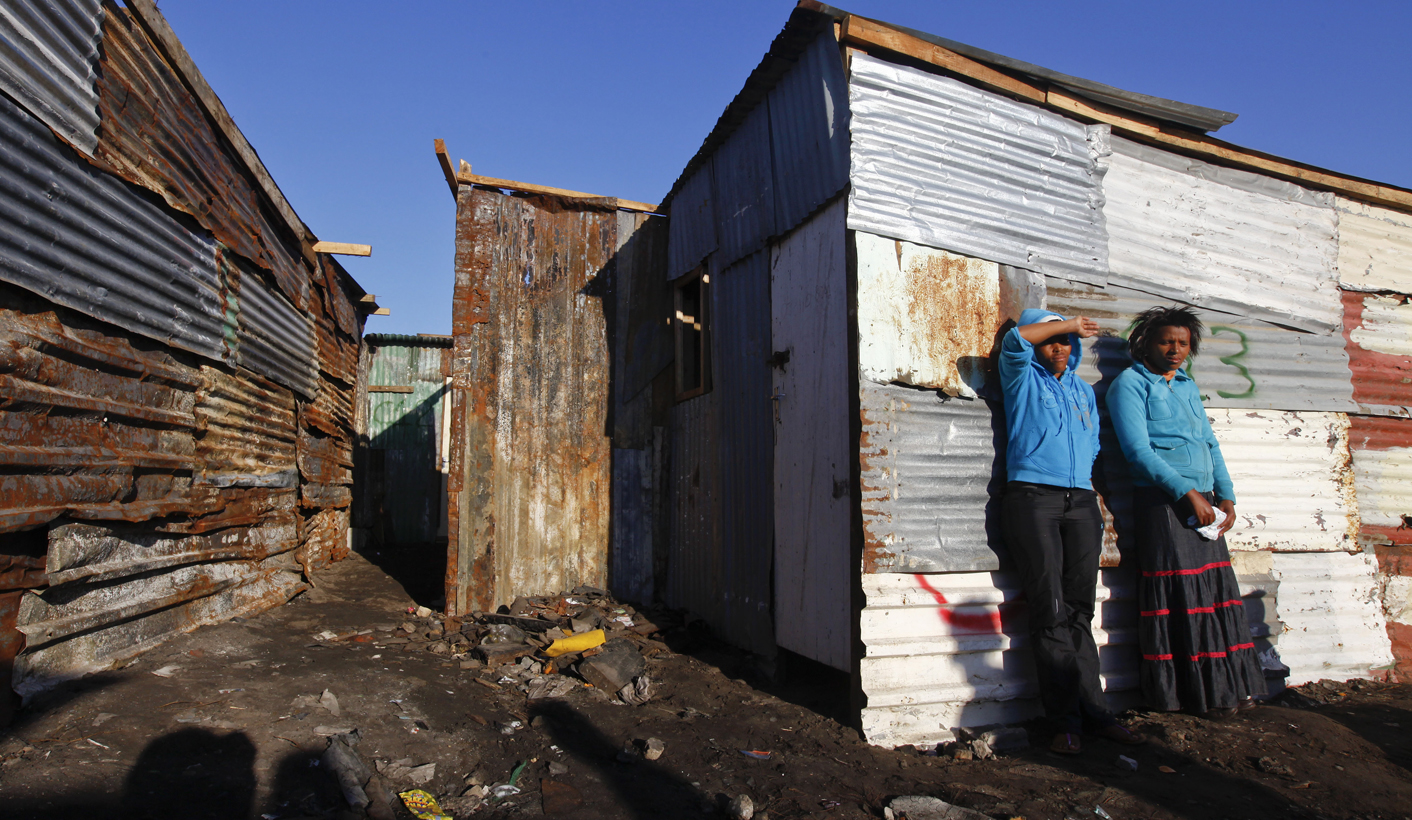
In old black-and-white photographs, the antiapartheid activist Ahmed Timol looks elegant, with an open face and a ready smile. One classic shot captures him midstride. Clad in dark sunglasses with a pipe dangling from his mouth, he has the dashing air of a 1950s film star. Shortly after that photo was taken, on October 25, 1971, Timol—a member of the South African Communist Party—was arrested. Two days later, he was dead. His body was found on the pavement outside the headquarters of the notorious Security Branch of the apartheid police in Johannesburg. An inquest overseen by an apartheid judge determined that Timol had committed suicide by jumping from a window. He was not yet 30.
Forty-six years later, on an October morning in 2017, a court in the now democratic South Africa ruled that Timol had been murdered. The police had lied, and the judge had covered up their crime. Far from being a redemptive tale, the Timol case marked an unsatisfactory end to a long and difficult journey for Timol, his family, and the antiapartheid activists who still remember him. Even Archbishop Desmond Tutu—long a champion of forgiveness—seemed frustrated by the state’s foot-dragging. His statement on the matter summed up the ambivalence many in South Africa feel about the relationship between truth and justice: “It is sad it took so long,” he said. Almost five decades after Timol’s murder, two of the three policemen found responsible for his death are no longer alive, having died without ever having to answer to a judge. The third will now face murder charges for Timol’s death.
For many South Africans who watched the proceedings on television, the Timol case served as a reminder of the inadequacy of the much-touted truth-and-reconciliation process. Although it provided a forum for victims of human rights abuses and the perpetrators of those crimes to come together and seek truth and forgiveness, it failed to address the deeper wounds of apartheid that continue to plague South Africa. Today, many look back on the process as a carefully managed stage show—a piece of theater concerned with the appearance of truth-telling rather than the substance of what the truth actually means.
South Africa has been heralded as a beacon of national unity, but the emphasis on individual crimes has distracted from the broader sins of apartheid. Twenty-three years after the transition to democracy, the wider systemic racial and economic inequalities that have kept most black South Africans poor while preserving the wealth and privilege most white South Africans enjoyed under apartheid remain firmly in place.
WHEN RACISM IS POLICY
For centuries, South Africa suffered under the yoke of colonialism. The first Europeans began colonizing what is now South Africa in 1652, with the arrival of the Dutch. After defeating the Dutch in the Boer War of 1899–1902, the British established the Union of South Africa, a dominion of the British Empire. In 1913, its all-white government passed the Natives Land Act, confining Africans to ownership of land in only seven percent of the country. In spite of their smaller numbers, whites were free to own or lease land in the other 93 percent of South Africa.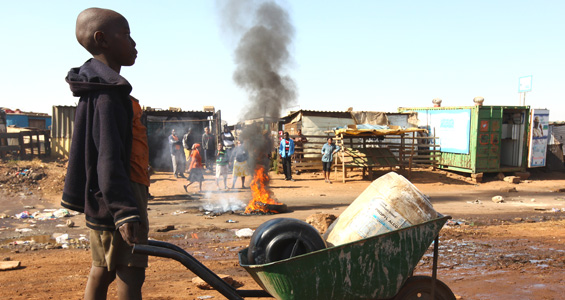
It was only in 1948, once the National Party (NP) took power, that apartheid became official state policy. Through legislation, the NP enforced a wide-ranging system of racial segregation that curtailed the freedom of movement and association of the black majority and other nonwhite ethnic groups while maintaining white minority rule through brute force and formal disenfranchisement. Central to this racial caste system was a set of racial categories invented by apartheid’s architects: white (of European ancestry), African (black), Coloured (of mixed racial heritage), and Indian (descended from South Asian immigrants). In ways both small and large, the policy codified racism. What was referred to as “petty apartheid” was enforced through laws and regulations that segregated public facilities such as benches and drinking fountains. “Grand apartheid” dictated where blacks and whites could live and work, what sorts of jobs they could apply for, and where and when they could travel. Multiracial communities were destroyed, and African, Coloured, and Indian people were forcibly removed from places designated for whites.
The apartheid state invested significant energy in legitimizing racial discrimination by projecting the idea that the codification of racism was not only acceptable but also just. Apartheid officials rolled out extensive propaganda campaigns aimed at convincing the international community that black South Africans enjoyed high standards of living under a policy of “separate development.” And they created a complex system of “homelands” (or “Bantustans”)—territories set aside for Africans in miserable and often arid areas. Bantustans were created to legitimize the disenfranchisement of blacks in South Africa by stripping them of their citizenship and pretending as though they were citizens of new countries that had been created by the apartheid regime. They were also established to give the false impression that blacks enjoyed self-rule and autonomy. The Bantustans may have been a farcical attempt to prop up the ideology of separate development, but the apartheid regime wasn’t entirely dismissed. It had a measure of respectability, in part because of the geopolitics of the time. The Cold War shadowed apartheid’s worst years, and much of the NP’s propaganda hinged on the idea that white minority rule was the last line of defense against communism in Africa.
So egregious was the legal regime in South Africa that in 1973, the UN General Assembly declared that apartheid represented “inhuman acts committed for the purpose of establishing and maintaining domination by one racial group of persons over any other racial group of persons and systematically oppressing them.” This definition cut to the core of what the apartheid state wished to evade. The South African state was deeply invested in appearing to be just. Indeed, in South Africa, the appearance of justice has always been far more important than justice itself. Like all systems of racial segregation, apartheid derived its respectability from the law.
The emphasis on individual crimes has distracted from the broader sins of apartheid.
As such, the country’s white rulers were deeply respectful of the laws they created and were careful to manage a democracy, albeit one that catered only to whites. The pretense that white minority rule was a legitimate enterprise permeated all aspects of life; it was crucial that the white population accept this idea, because without their buy-in, the system would have collapsed. Apartheid-era leaders gained credibility by holding regular elections (but in which only whites could vote) and building schools for blacks (who lived in designated segregated areas). The entire façade of legalism behind which apartheid was built was rooted in the quest to make a deeply amoral system appear respectable.
CONFESSION TIME
By the mid-1980s, the apartheid regime began to show signs of strain. A global movement to impose economic sanctions on South Africa was gaining steam abroad. At home, meanwhile, a unified protest campaign by antiapartheid activists succeeded in making the country ungovernable, and in 1985, the government declared a state of emergency. By the end of the decade, the country was burning.
The NP, which had sustained apartheid for over 40 years, could see the writing on the wall. In 1990, as a result of initially secret negotiations with the antiapartheid activist Nelson Mandela’s banned party, the African National Congress, the NP agreed to remove the prohibition on all other political parties. It also agreed to release all political prisoners, including Mandela, who had languished behind bars for nearly three decades on charges of treason. Two years later, white South Africans voted formally through a referendum to end their minority rule, giving the country’s president, F. W. de Klerk, a clear mandate to enter into open talks that would pave the way for a new fully democratic dispensation. But the road to democracy was punctuated by political violence. In 1993, for example, Chris Hani, one of the ANC’s most beloved leaders, was assassinated by white supremacists. In response, Mandela chose peace over retribution, calling on his supporters to stay calm and returning to the negotiating table. In 1994, the country held the historic elections that made him president.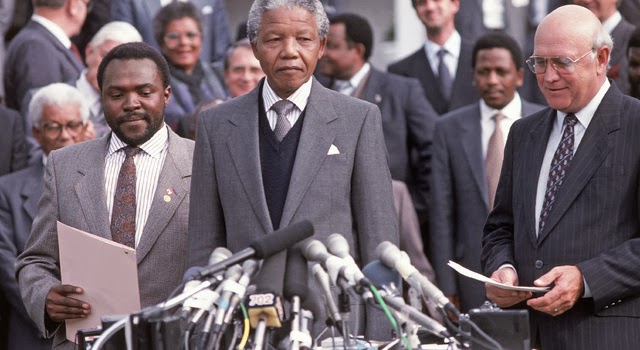
By using negotiations rather than armed insurrection, Mandela and his comrades averted civil war and sheltered whites from mass violence. But as part of the tradeoff, whites were supposed to be truly, genuinely, and everlastingly sorry for the sins that had been committed against blacks in their name. To underscore this idea, Mandela’s government established the Truth and Reconciliation Commission, which led a quasi-legal process intended to “bear witness,” record, and, when appropriate, grant amnesty to the perpetrators of crimes of apartheid. Chaired by Tutu, the TRC included well-respected human rights activists and legal minds and was influential in shaping South Africa’s narrative of forgiveness and redemption.
Although the outgoing regime had pushed hard for a blanket amnesty that would shield perpetrators from any form of prosecution in the interests of moving forward in peace, the ANC insisted on a different arrangement. As an inducement to telling the truth, the TRC offered perpetrators amnesty from both civil and criminal prosecution if they could convince the commission that their crimes had been committed to further political objectives and that they had disclosed everything they knew. In effect, the TRC provided a “get out of jail free” card to those claiming ideological motives.
The commission was also charged with the task of determining if victims of gross human rights abuses were entitled to any reparations and what those might be, as well as making recommendations about rehabilitating perpetrators, supporting victims, and putting in place institutional reforms to ensure that the post-apartheid state did not commit similar crimes. The TRC’s investigations often culminated in televised public hearings that opened in prayer and ended with the singing of biblical hymns or songs from the liberation struggle—emotional bookends that marked important public symbols of the private pain that families and communities had been carrying for years.
The TRC’s work was premised on the idea that truth was an essential first step toward healing. For the first time in South Africa’s history, whites would be forced to listen to blacks. Victims even had the right to question perpetrators, who in turn were encouraged to tell the truth in the interests of national unity and reconciliation. For many black people whose lives had been defined by taking orders from whites, whose daily routines and living patterns had been shaped by the whims of whites, and whose opinions and needs had been dismissed by whites and by the system of apartheid they had built to protect themselves, the TRC offered more than the truth; it offered a chance to regain their dignity.
At the hearings, victims gave harrowing statements about their experiences, and perpetrators described horrible crimes. One jarring confession resolved the cold case of Sizwe Kondile, a member of the ANC who had disappeared in 1981. It took 17 years for the truth to come out. Dirk Coetzee, a police commander who ran a series of farms where antiapartheid activists were taken to be tortured and killed, testified to having covered Kondile with a balaclava and shooting him in the head. He and his men then threw Kondile’s body onto a fire and spent the evening drinking and eating as the corpse roasted. The following morning, only ashes remained. Coetzee and the three other men who had participated in the crime all received amnesty.
There was a strongly confessional element to the TRC’s operation; sinners came to the hearings seeking absolution, and victims came seeking to forgive so they might be liberated from their pain. Some people saw the entire process as a religious experience. Indeed, as its chair, Tutu encouraged such thinking. In interviews, he often spoke of the acts of contrition and forgiveness he witnessed as “miracles.” In a 1997 speech, Tutu said, “Many times I have felt we should take our shoes off because we were standing on holy ground.” At the time the commission was carrying out its work, South Africa was lauded as an example of a country in which truth had triumphed over tragedy. Indeed, since then, there have been over 1,000 other truth-and-reconciliation commissions established across the world—from Chile and Guatemala to Nepal and Sierra Leone.
FORGIVING AND FORGETTING
Although the TRC offered a chance for many families to hear the truth about what happened to their loved ones, its mandate was too narrow to encompass the range of injustices that had been perpetrated. By fetishizing individual human rights violations, it sidestepped the structural impacts of apartheid. As the political scientist Mahmood Mamdani has noted, the TRC effectively ignored the systematic dispossession of blacks, even though state-enforced black poverty was a deliberate outcome of apartheid. It was accomplished through forced removals from cities, separate and unequal education, the deprivation of basic democratic rights, and, most important, the explicit reservation of certain kinds of jobs for whites and the exclusion of black people from certain categories of study and employment. Mamdani has argued that South Africa’s failure to include broader policy-based forms of discrimination in the TRC’s mandate “ignored Apartheid as experienced by the broad masses of the people of South Africa.”
The TRC never tried to treat most of the enduring wounds of apartheid.
The TRC’s narrow focus resulted in the exclusion of 3.5 million victims of forced relocations alone. If one considers those who were victims of the so-called pass laws, which limited black people’s movement and work opportunities, or those who were victims of the substandard education, it becomes clear that the process failed to address the vast majority of apartheid’s victims. In other words, the TRC never tried to treat most of the enduring wounds of apartheid.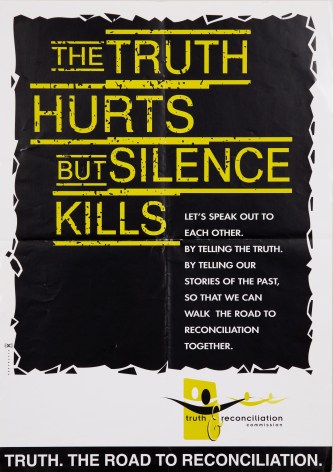
Instead, forgiveness became a national mantra, and reconciliation an official ideology. Progress toward nation building was measured by the march of forgiveness. To be a good new South African, you had to leave anger in the past. Although the TRC allowed victims of apartheid to express grief and pain, it did little to encourage and listen to those who were unprepared to either forgive whites collectively or assuage the guilt of those who had perpetrated crimes against their relatives. Many murderers, such as Coetzee, confessed in public and then walked free. Whether or not those who had caused the pain were sorry was in some ways irrelevant. The preoccupation with forgiveness and the future was a problem that plagued not just the TRC but all of South African society in the 1990s. The new rulers were so worried that the country would be engulfed in bitterness that they did not provide sufficient space for conversations about the persistent injustices of the present.
Today, white South Africans seem to be suffering from collective amnesia—a mass forgetting of just how bad things could have been if the transition to democracy had not been managed so well by the ANC and its followers. Meanwhile, black South Africans have grown increasingly bitter toward the TRC. This growing cynicism is linked to the sense that for whites, the end of apartheid did not signal the end of privilege, just as it has not signaled the end of suffering for the majority of black people.
The power imbalances that defined race relations under apartheid continue to exist. In a 2015 poll of South Africans, for example, over 60 percent of white respondents said that they had access to the financial resources they need to achieve their goals, whereas only 43 percent of black respondents and 26 percent of Coloured respondents said that they did. Worse yet, a series of high-profile incidents of unrepentant white racism that have gone viral in recent years—including a shocking video clip of a group of white university students forcing the black cleaning staff in their residences to eat dog food mixed with urine—has underscored the widespread sense that blacks have been too gracious.
UNFINISHED BUSINESS
While South Africans are rightly proud of the fact that they averted a race war by choosing talks over guns, and by choosing to put in place a forum for grief rather than letting rage run rampant, the endurance of the attendant peace should not be taken for granted. Over time, it has become evident that there can be no sustained improvement in race relations without addressing entrenched economic inequality. As South Africa’s economy stagnates under the poor leadership of its current president, Jacob Zuma, the deferred dream of reconciliation festers like a sore. Unemployment now stands at a staggering 31 percent among black South Africans and 23 percent among Coloureds. For whites, the figure is just under seven percent. It is only a matter of time before the resulting anger becomes explosive.
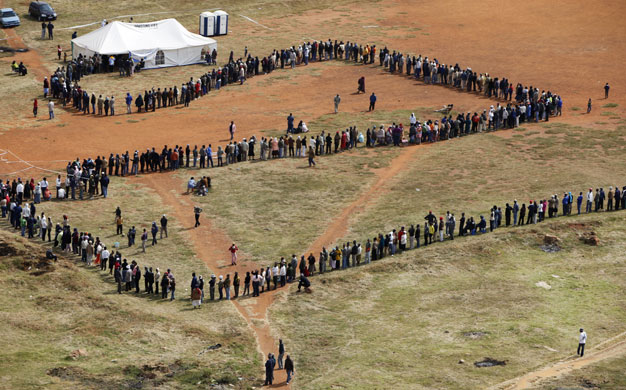
Already, by the South African government’s own measure, there are approximately 60 protests each day. More than two decades after democracy came to South Africa, bitterness about apartheid is not merely confined to those who lost loved ones or who were themselves victims of gross human rights violations. Anger is rife among the unemployed and the urban poor, whose housing conditions remain appalling as a direct result of apartheid. It is palpable among the young, who feel entitled to education under a democratic government yet who cannot afford the tuition. Meanwhile, white South Africans continue to enjoy the residual comforts of a system that was created to benefit them, without seeming to have a sense of how lucky they have been or are. It is this growing resentment, coupled with whites’ collective shrugging of their shoulders despite the grace they have been given, that lies at the root of the tension in contemporary South Africa.
But the most severe criticism has been aimed at black leaders, who negotiated what is now widely seen as a flawed peace in 1994. Those who have done nothing about prosecuting apartheid-era crimes, and who have failed to address the hopelessly unjust economic and social order they inherited while enriching themselves, are likely to face the wrath of South Africa’s poorest and most desperate citizens—those whom reconciliation left behind.
A genuine truth-and-reconciliation process would have aimed to address not just serious human rights violations but also the socioeconomic effects of apartheid. There would have been a two-pronged process of investigations. One set of investigations would have focused on murders and disappearances, just as the TRC did. The other would have calculated the economic costs of apartheid for black South Africans and set aside resources to redress them. It would also have looked at such issues as land seizures, forced removals, pass laws, and Bantustans with a view toward working out financial compensation packages, which could have been paid in cash or taken the form of state benefits, such as pensions or grants for higher education. To fund these payouts, the new government could have made arrangements with large banks, mining companies, and other institutions that profited handsomely from apartheid. A special apartheid tax, applied over an extended period of ten or 15 years, could have addressed the concern that the innocent new state should not have to pay the debts of its guilty predecessor.
To put it simply, in the years after 1994, the ANC ought to have been bolder. In part, it was afraid of upsetting the markets and thought it had to respect the existing economic order. Given its close ties with the South African Communist Party, the ANC also felt the need to disavow policies that seemed too left-leaning. But in its haste to appear moderate, the ANC missed an opportunity to capitalize on the global goodwill directed toward its leaders after they managed a complex and fraught transition with remarkable humanity. The party failed to ensure that the new South Africa was not simply a new democratic polity but a country genuinely committed to economic justice and equality.
Today, South Africa appears to be just. It has vibrant and thriving media, a court system to rival any in the world, and a constitution that is the envy of many nations. Just like the old one, the new South Africa has done a sterling job of maintaining the appearance of justice. But it has done less well at achieving actual justice by banishing the inequalities that apartheid created. Many South Africans admit that when Justice finally appears, she may come clothed in the flames of retribution. This fate is not inevitable, but if the fire is to be averted next time, it will require courage and commitment from a new generation of leaders. And this time, those in charge must not privilege the fears of the few over the needs of the many.
